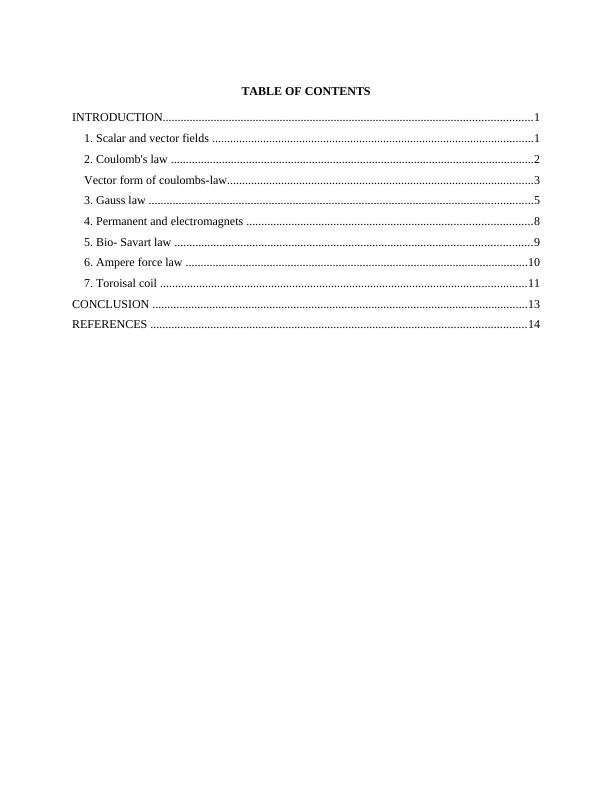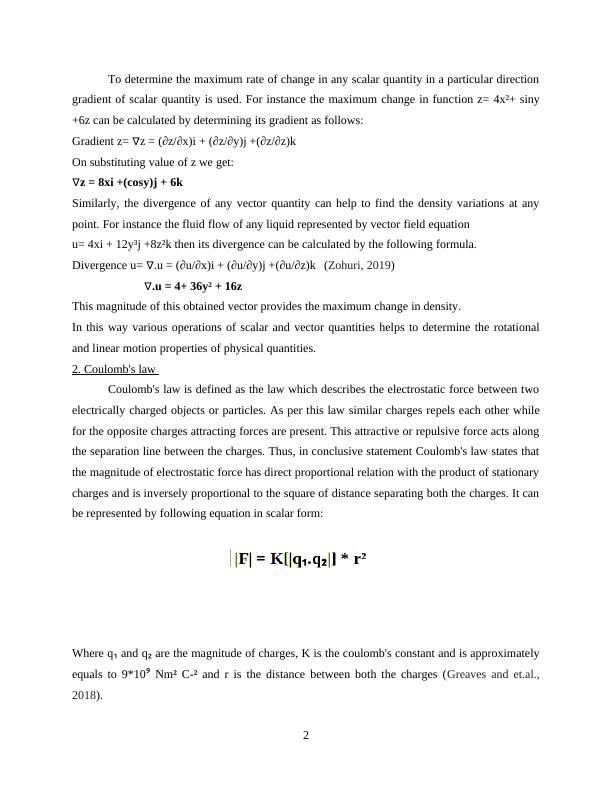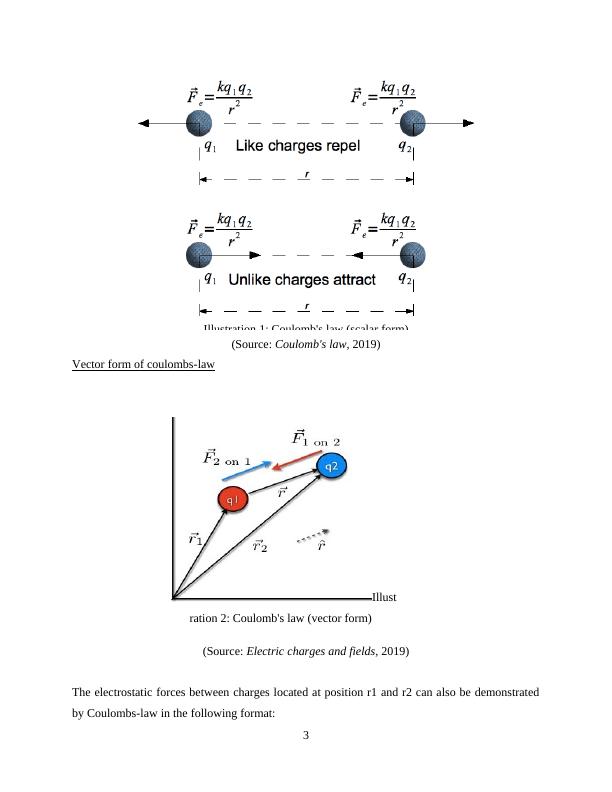Electromagnetic Devices | Assignment
Added on 2020-12-10
22 Pages4260 Words406 Views
Electromagnetic devices

TABLE OF CONTENTS
INTRODUCTION...........................................................................................................................1
1. Scalar and vector fields ...........................................................................................................1
2. Coulomb's law .........................................................................................................................2
Vector form of coulombs-law......................................................................................................3
3. Gauss law ................................................................................................................................5
4. Permanent and electromagnets ...............................................................................................8
5. Bio- Savart law .......................................................................................................................9
6. Ampere force law ..................................................................................................................10
7. Toroisal coil ..........................................................................................................................11
CONCLUSION .............................................................................................................................13
REFERENCES .............................................................................................................................14
INTRODUCTION...........................................................................................................................1
1. Scalar and vector fields ...........................................................................................................1
2. Coulomb's law .........................................................................................................................2
Vector form of coulombs-law......................................................................................................3
3. Gauss law ................................................................................................................................5
4. Permanent and electromagnets ...............................................................................................8
5. Bio- Savart law .......................................................................................................................9
6. Ampere force law ..................................................................................................................10
7. Toroisal coil ..........................................................................................................................11
CONCLUSION .............................................................................................................................13
REFERENCES .............................................................................................................................14

INTRODUCTION
Electromagnetic devices are based upon the principles of electric and magnetic
interaction as varying electric fields produces magnetic field and vice versa. The report will
discuss the various concepts and laws on which electromagnetic devices work upon.
1. Scalar and vector fields
Scalar quantities are defined as the entities which are characterised by magnitude only
and does not have any specific direction. On the other hand vector quantitate are known to be
entities with both direction and magnitude. For instance quantities like electric charge, distance
and mass are called scalar while velocity, displacement and magnetic fields are vectors (Jiles,
2015). In electromagnetic theory fields are defined as the quantities which are function of
position and may also depends upon time or other customised variables.
On the basis of nature of quantities fields are classified as scalar or vector fields. For
example temperature is scalar quantity and temperature distribution in any rod is scalar field
because at every point in the specified region of rod scalar function has defined value. Similarly,
in velocity filed of moving object at every location value of vector function is defined so that the
entire region is known as vector field.
Use and practical implementation:
Both scalar and vector fields are employed and analysed for variety of applications and
purpose. Vector fields are used in modelling the directional and magnitude aspects of fluids or
the physical quantities such as force or velocity. These fields are also an integral part of integral
and differential calculus (Tran, 2018). For instance this usage of vector field is implemented in
determining work done, interpretation of energy conservation, flow rotation (curl) and changes in
fluid flow volume (divergence). Along with the vectors, scalar fields are also used in quantum
theory and to underpin the applications based upon theory of relativity.
The distribution of scalar quantities such as spin zero, temperature and pressure
distribution within space or different objects be determined only with the application of scalar
and vector operations. The fields such as electric potential or gravitational forces cannot be
described without discussion of implementation of scalar and vector fields. The scalar quantities
are used in meteorology while the vector fields find their application in the electromagnetic
devices (Farrow, 2019).
Numerical example:
1
Electromagnetic devices are based upon the principles of electric and magnetic
interaction as varying electric fields produces magnetic field and vice versa. The report will
discuss the various concepts and laws on which electromagnetic devices work upon.
1. Scalar and vector fields
Scalar quantities are defined as the entities which are characterised by magnitude only
and does not have any specific direction. On the other hand vector quantitate are known to be
entities with both direction and magnitude. For instance quantities like electric charge, distance
and mass are called scalar while velocity, displacement and magnetic fields are vectors (Jiles,
2015). In electromagnetic theory fields are defined as the quantities which are function of
position and may also depends upon time or other customised variables.
On the basis of nature of quantities fields are classified as scalar or vector fields. For
example temperature is scalar quantity and temperature distribution in any rod is scalar field
because at every point in the specified region of rod scalar function has defined value. Similarly,
in velocity filed of moving object at every location value of vector function is defined so that the
entire region is known as vector field.
Use and practical implementation:
Both scalar and vector fields are employed and analysed for variety of applications and
purpose. Vector fields are used in modelling the directional and magnitude aspects of fluids or
the physical quantities such as force or velocity. These fields are also an integral part of integral
and differential calculus (Tran, 2018). For instance this usage of vector field is implemented in
determining work done, interpretation of energy conservation, flow rotation (curl) and changes in
fluid flow volume (divergence). Along with the vectors, scalar fields are also used in quantum
theory and to underpin the applications based upon theory of relativity.
The distribution of scalar quantities such as spin zero, temperature and pressure
distribution within space or different objects be determined only with the application of scalar
and vector operations. The fields such as electric potential or gravitational forces cannot be
described without discussion of implementation of scalar and vector fields. The scalar quantities
are used in meteorology while the vector fields find their application in the electromagnetic
devices (Farrow, 2019).
Numerical example:
1

To determine the maximum rate of change in any scalar quantity in a particular direction
gradient of scalar quantity is used. For instance the maximum change in function z= 4x²+ siny
+6z can be calculated by determining its gradient as follows:
Gradient z= z = (∂z/∂x)i + (∂z/∂y)j +(∂z/∂z)k∇
On substituting value of z we get:
z = 8xi +(cosy)j + 6k∇
Similarly, the divergence of any vector quantity can help to find the density variations at any
point. For instance the fluid flow of any liquid represented by vector field equation
u= 4xi + 12y³j +8z²k then its divergence can be calculated by the following formula.
Divergence u= .u = (∂u/∂x)i + (∂u/∂y)j +(∂u/∂z)k∇ (Zohuri, 2019)
.u = 4+ 36y² + 16z∇
This magnitude of this obtained vector provides the maximum change in density.
In this way various operations of scalar and vector quantities helps to determine the rotational
and linear motion properties of physical quantities.
2. Coulomb's law
Coulomb's law is defined as the law which describes the electrostatic force between two
electrically charged objects or particles. As per this law similar charges repels each other while
for the opposite charges attracting forces are present. This attractive or repulsive force acts along
the separation line between the charges. Thus, in conclusive statement Coulomb's law states that
the magnitude of electrostatic force has direct proportional relation with the product of stationary
charges and is inversely proportional to the square of distance separating both the charges. It can
be represented by following equation in scalar form:
Where q and q are the magnitude of charges, K is the coulomb's constant and is approximately
equals to 9*10 Nm² C-² and r is the distance between both the charges (Greaves and et.al.,
2018).
2
gradient of scalar quantity is used. For instance the maximum change in function z= 4x²+ siny
+6z can be calculated by determining its gradient as follows:
Gradient z= z = (∂z/∂x)i + (∂z/∂y)j +(∂z/∂z)k∇
On substituting value of z we get:
z = 8xi +(cosy)j + 6k∇
Similarly, the divergence of any vector quantity can help to find the density variations at any
point. For instance the fluid flow of any liquid represented by vector field equation
u= 4xi + 12y³j +8z²k then its divergence can be calculated by the following formula.
Divergence u= .u = (∂u/∂x)i + (∂u/∂y)j +(∂u/∂z)k∇ (Zohuri, 2019)
.u = 4+ 36y² + 16z∇
This magnitude of this obtained vector provides the maximum change in density.
In this way various operations of scalar and vector quantities helps to determine the rotational
and linear motion properties of physical quantities.
2. Coulomb's law
Coulomb's law is defined as the law which describes the electrostatic force between two
electrically charged objects or particles. As per this law similar charges repels each other while
for the opposite charges attracting forces are present. This attractive or repulsive force acts along
the separation line between the charges. Thus, in conclusive statement Coulomb's law states that
the magnitude of electrostatic force has direct proportional relation with the product of stationary
charges and is inversely proportional to the square of distance separating both the charges. It can
be represented by following equation in scalar form:
Where q and q are the magnitude of charges, K is the coulomb's constant and is approximately
equals to 9*10 Nm² C-² and r is the distance between both the charges (Greaves and et.al.,
2018).
2

(Source: Coulomb's law, 2019)
Vector form of coulombs-law
(Source: Electric charges and fields, 2019)
The electrostatic forces between charges located at position r1 and r2 can also be demonstrated
by Coulombs-law in the following format:
3
Illustration 1: Coulomb's law (scalar form)
Illust
ration 2: Coulomb's law (vector form)
Vector form of coulombs-law
(Source: Electric charges and fields, 2019)
The electrostatic forces between charges located at position r1 and r2 can also be demonstrated
by Coulombs-law in the following format:
3
Illustration 1: Coulomb's law (scalar form)
Illust
ration 2: Coulomb's law (vector form)

Practical implementation and applications:
The principles of electrostatic forces are widely used in printing and xerography
processes. Thus, law is used and practically applied in the functioning of Xerox and printing
machines. Though most of the applications of this law are indirect and rare but have great
significance. For instance protons within nucleus of atoms are held by strong repulsive forces
thus Coulomb's law is used to find that force so that electron transfer and reactions can be
understand and controlled (Chen, 2018). For explaining and utilising the various phenomenons
of quantum physics electrostatic forces are calculated using this law. Coulombs force is also
found to be the basic force which binds molecules of atoms and helps them to retain their solid or
liquid state. As compare to gravitational force, Coulomb's force is stronger but is usually not
visible.
Numerical examples:
Coulomb's force is used for analysing the behaviour and pattern of electrostatic forces by
calculating the forces between two charges. This can be understood by following examples.
When two forces of charge +4 mC and -5 mC are placed at distance of 30 mm in free space then
the force of attraction between both of these charges is equals to:
= (9*10 ) (-5* 10 ̄ ) (4* 10 ̄ ) / (0.03)²
F = -200 N
Example 2:
Three charges A, B, C of 1mC, 2mC and -3mC are placed on x axis. Distance between charge A
and B is 0.12 m and that between A and C is 0.42 m. Find the force on charge B?
4
The principles of electrostatic forces are widely used in printing and xerography
processes. Thus, law is used and practically applied in the functioning of Xerox and printing
machines. Though most of the applications of this law are indirect and rare but have great
significance. For instance protons within nucleus of atoms are held by strong repulsive forces
thus Coulomb's law is used to find that force so that electron transfer and reactions can be
understand and controlled (Chen, 2018). For explaining and utilising the various phenomenons
of quantum physics electrostatic forces are calculated using this law. Coulombs force is also
found to be the basic force which binds molecules of atoms and helps them to retain their solid or
liquid state. As compare to gravitational force, Coulomb's force is stronger but is usually not
visible.
Numerical examples:
Coulomb's force is used for analysing the behaviour and pattern of electrostatic forces by
calculating the forces between two charges. This can be understood by following examples.
When two forces of charge +4 mC and -5 mC are placed at distance of 30 mm in free space then
the force of attraction between both of these charges is equals to:
= (9*10 ) (-5* 10 ̄ ) (4* 10 ̄ ) / (0.03)²
F = -200 N
Example 2:
Three charges A, B, C of 1mC, 2mC and -3mC are placed on x axis. Distance between charge A
and B is 0.12 m and that between A and C is 0.42 m. Find the force on charge B?
4

End of preview
Want to access all the pages? Upload your documents or become a member.
Related Documents
Electromagnetic Devices: Principles, Concepts, and Applicationslg...
|17
|4429
|45
Electromagnetic Deviceslg...
|21
|4565
|33
Assignment on Electromagneticlg...
|21
|4446
|373
Handbook of Differential Equationlg...
|12
|940
|27
